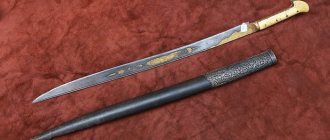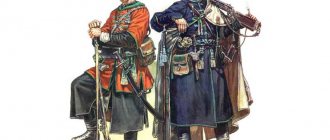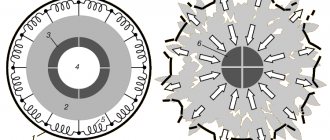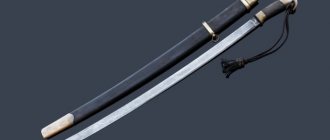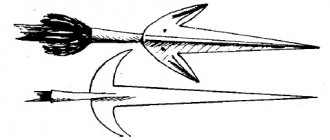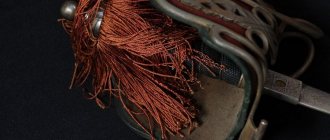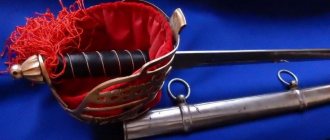The time when the curved saber blade appeared on the battlefields has not been recorded by anyone. But it is known that sabers first appeared on the territory of modern Iran and Turkey; these were the early varieties of these weapons, the kilych and the shamshir saber. After the Crusaders, these blades became widespread in Europe. They appeared in Rus' with trade guests and received excellent praise from the soldiers.
It should be noted that not only the Turks and Europeans appreciated the cutting power of the curved blade, the Far East went its own way as usual. It was there that curved two-handed swords appeared. The famous katana and Chinese dadao, these swords with a curved cutting surface were developed in the countries of the east.
Design
The classic saber had a slightly curved blade up to 850-900 mm long, the bend could be up to 50-70 mm, sharpened on the convex side. The upper third of the blade, up to the tip, was called elman; some sabers on elman had additional sharpening.
Along the blade part of the weapon there were valleys, which are sometimes called blood flows, although in reality they played a completely utilitarian role as stiffening ribs. The back of the blade was called the butt.
The Polish saber was already different from the eastern ones in its bend.
Later changes affected the hilt. European weapons had a full-fledged guard with a bow or several bows. The handle itself is in the form of an oval or ellipsoid in cross-section on the same axis as the blade. The butt plate usually had a hole for a lanyard.
The following types of sabers were distinguished by type of activity:
- cavalry, with a long blade and an indistinct tip;
- infantry, shorter blade, simplified handle;
- sea or boarding, usually pronounced elman, strongly curved blade, developed tip, most often closed handle.
The general appearance of the blade depended greatly on the conditions of its use. In addition to the statutory samples, noble officers often bought themselves more expensive, and therefore durable, blades made of Damascus steel or damask steel.
Article about sabers
“...Like pine trees under an ax, every minute one of the reitar, with his head bowed in a sparkling helmet, fell under the hooves of his horse. The sabers of the Kmitsa Tatars flashed before their eyes, blinded them, whistled near their faces, eyes, hands. In vain the mighty warrior raised his heavy sword: before he could lower it, he felt the icy cold of the blade in his body, and the sword fell out of his hands, and he buried his bloody face in the horse’s mane.”
Henryk Sienkiewicz. "Flood"
So, the sword and the saber collided, and the saber won. It turned out to be not only more effective and convenient, but also its appearance, its smooth curve, may seem to many more fabulous and magical than the straight blade of a knight’s sword... especially lately. More and more often, a simple sword is being exchanged for something curved. More often, “curved” blades are awarded to elves, less often to representatives of other races, and in Tolkien, if you remember, only orcs and various short-sighted barbarians were awarded with curved blades. In fact, short curved swords are the favorite weapons of the Evil races in fantasy.
For example, counting on the majority, I will again cling to Tolkien. His orcs choose scimitars, and any other crookedness because, so to speak, of a “national characteristic” or an even wilder formulation: because of “cultural tradition.” Sometimes the author is guided by personal preferences, well, he loves katanas and that’s it! But much more often the choice falls on the sword.
Why is this so? Especially considering the hypothesis just stated about the greater effectiveness of the saber. Firstly, the reason for this is the place of origin of the curved sword, secondly, the method of its manufacture and, thirdly, the sword is a symbol of nobility, and most curved weapons have a sharpened concave part, reminiscent of a very specific agricultural tool - a sickle, if you will, a working tool allegorical death - a scythe.
Both curved and straight swords appeared in the Bronze Age.
The East followed its own path in developing types and forms of edged weapons. The Middle East - Turkey, Persia, as well as the steppe nomads of Asia, and partly India (via Persia) exerted their influence on the eastern part of Europe. The edged weapons of the Far East - Japan, China - developed completely in isolation. The Kiev and Moscow states, being at the crossroads of trade routes, could borrow and choose the most convenient forms of edged weapons from the West and the East.
The main purpose of the curvature of the blade was to give the center line of the chopping weapon the line of direction of the blow, that is, so that both of these lines of the chopping weapon and the direction of the blow would coincide, and not be at an angle to each other. In this case, the curved part of the blade serves as a rudder during the swing and forces the blade to coincide with the line of impact.
In addition to all the parts of a straight sword, the curved one had one more detail: elman - an extension in the warhead of the blade with a double-sided (double-blade) sharpening, turning into an edge and intended to make the blade heavier and increase the force of the blow. This element is found mainly in eastern sabers.
The strange addition “with double-sided sharpening” is an important detail, since a curved sword as standard could only have one cutting edge. And this, in the era of weapons production by welding iron and steel, meant half the service life. After all, when struck, the blades quickly dulled and became jagged; due to the rigidity of the metal, the blades crumbled. But the curved sword often had a massive grooved butt. Sometimes several rings were even inserted into the holes on the butt. The accessory served a certain practical purpose: if you take an enemy’s blow on the grooves or on the rings themselves, you can have some good fun with an unarmed person.
A curved sword had some advantages, while a straight sword had others. But the advantages of straight swords for a long time outweighed all their disadvantages. Mainly due to the need for the rider to have a long blade, and due to the inability to deliver slashing blows while standing in line. A curved blade was suitable only for an individualist fighter.
So, in order to lengthen the blade and make it more durable, a different weapon production technique was needed and preferably a different material - elastic steel or damask steel. Guess where the secret of its manufacture was found? Well, yes. In the East, or rather in India, a simpler recipe was later found in China, where patterned Damascus steel came from.
Improvements in the quality of steel made it possible to create long and light curved swords. From that moment on, they really began to be of interest to riders. After all, they needed a blade that was both long, light and well suited for cutting.
Curve and straight swords differed primarily in balance. The center of gravity of a straight sword was located at the level of the guard or several centimeters higher. The curved sword was balanced approximately in the middle of the blade. And primarily intended for a slashing blow. The advantages of a curved blade for chopping are obvious: the inclined and sliding position of the blade in relation to the struck body upon impact adds the cutting property of the knife to the chopping-crushing blow. All this allows a lighter blade to achieve the same effect as a heavy chopping sword - the hand gets less tired when using a saber. The bending of the chopping edge made the blade more durable, and the high location of the center of gravity significantly increased its penetrating power. While the straight sword, thanks to its “low” centering, was a very convenient and fast weapon and opened up ample opportunities for piercing strikes, it cut in half with grief, and then with a weight of 2.5 to 3.5 kg. With such a weight, the “fast and easy” points were carried out only in the hands of those who were not weak.
| Scimitar |
A radical improvement in the quality of the material allowed riders to acquire light cutting weapons. This is how the scimitar appeared - a sword weighing about 1-1.4 kg with a curved blade, widening towards the tip, 70-90 cm long. Scimitars turned out to be a successful acquisition not only for cavalry, but also for infantry. The infantry used them to chop the heads of... horses. For such purposes, two-handed (!) scimitars were made; they weighed 2.5-3.5 kg and the blade reached 100-120 cm.
In the Middle East, scimitars began to be used back in the 6th-7th centuries and for a long time they were a great treasure. Scimitars became commonplace in the 14th century, and already in the 15th they were replaced by sabers.
The saber is the perfect weapon of nature. Saber-toothed animals lived approximately 20 million years ago. Sabers soon appeared behind the scimitars and gradually replaced them.
According to the classification, sabers belong to cutting and piercing bladed weapons with a curved blade.
Regarding the saber, it can be said with reasonable probability that it is not genetically a continuation of either the ancient Greek mahaira or the German skramasax. The saber was brought to Europe from the Far East by the Huns in the form of a slightly curved weapon with one blade intended for cutting and thrusting.
| Saber Saif. Early sabers 9-12 were not very curved, but improvements in armor made sabers curved. When armor went out of fashion, sabers leveled off again. | The word saber comes from the Hungarian word zabli, which means “to cut.” Here is a reconstruction of an early Hungarian saber. |
The saber was the main type of Turkish edged weapon. It became widespread among nomadic peoples, including Seljuk tribes, in the 9th-10th centuries; the Ottoman Turks inherited the saber from the Seljuks. In the Ottoman Empire, the regular cavalry, the feudal feudal sipahs and the regular infantry - the Janissaries - were armed with sabers (although both of them also used scimitars).
Among the steppe nomads, the saber early took a dominant position. From here it penetrated into Rus' and already in the 12th century existed in parallel with the sword. It finally replaces the sword at the end of the 14th century. At 16, the Turkish type is first mastered, with a wide blade, even wider at the tip, where the widening is sharpened double-edged (elman). The blades were made by Russian craftsmen or imported in the form of semi-finished products, usually from Persia and Turkey, and were forged and assembled in the Moscow state.
Chivalry had a negative attitude towards crooked weapons.
The saber is rightfully considered one of the most advanced types of bladed weapons. Light and comfortable, it made it possible to quickly maneuver in battle. The saber blade, describing a wide amplitude, hit the enemy with the tip or the upper third of the concave part.
Improving the skills of blacksmiths made it possible to make the blade narrower and longer. Forging a blade with an elmanya was much more difficult than a flat one. But the saber blade, uniform in width, was convenient to put into its sheath.
Scimitars were not worn in scabbards, and this caused many inconveniences. It was difficult to come up with a comfortable sheath for a sword with a flaring blade. Short curved swords of the early Middle Ages were worn without sheaths - simply in the belt, like, for example, axes. It was impossible to tuck a Damascus steel blade into a belt - it would simply cut it.
Sometimes, for carrying, scimitars were equipped with their own straps - silk ribbons. One end of the tape was attached to the handle, the second was passed through an eye or ring in the butt. But carrying a sharp sword in this way was not only inconvenient, but also dangerous. So the saber was also more profitable in this regard.
The handle of the saber leaves the hand free, protection is achieved only by a cross with a crosshair. These are the two main types of eastern saber: Persian and Turkish. Closed saber hilts with different guards are already an invention of European gunsmiths, when, as a result of clashes with the Turks, the saber began to penetrate into Europe.
In the East, the saber enjoyed special honor. The craftsmen proposed numerous design solutions that made it possible to make the best use of the potential of these weapons. The combat effectiveness of a saber depended on the curvature of the blade, its weight, the location of the center of gravity and the axis of the handle. Famous eastern gunsmiths, unlike Western craftsmen, paid great attention to calculating the bend of the blade.
Strongly curved (up to 45 degrees) Iranian and Turkish blades had the greatest penetrating effect. Over time, the Turkish saber changed. Until the mid-17th century, combat sabers were made heavy and extremely sharp, which was explained by the need to hit an enemy carrying defensive weapons.
Thanks to the curvature, it was not the force of the blow that increased, but the blow itself changed: the cutting action was not concentrated at one point, but moved above or below the center of the blow. And elman increased the power of the blow. Yelman was sharpened on both sides, which made it possible to strike with the back of the blade.
Since the main purpose of weapons is to make killing one’s own kind as simple and convenient as possible, the evolution of the saber was closely related to the development of defensive weapons. In the early Middle Ages, when chain mail was the only protection, a weapon that could penetrate ring armor was required. The eastern saber was perfect for this - a slightly curved narrow long blade with a pointed end. With the advent of the mirror, bracers, and armor, the saber began to be made heavy - the elman appears and is gradually strengthened. Iron armor was retired, and the saber became lighter again, and its narrow blade with a steeper, well-calculated bend increased the cutting properties of the weapon.
| Tao | Klych (kilij) |
| Shamshir (shemshir) | Talwar (tulwar) |
In the East there was an incredible variety of types of sabers, but it is customary to single out only a few so-called “classical” types: the Turkish saber of the klych (kilych) or kilij type, the Iranian saber of the shamshir (shemshir) type, the Indian saber talvar (talwar), the Chinese Tao and sword- saber zulfaqar.
The klych saber (kilij) belonged to one of the main types of melee weapons of the Turkish army in general and the Janissary corps in particular (not a scimitar, but just a saber). The classic fang has a wide, thin blade in cross-section, with a curvature starting from 2/3 of the length. The end of the blade expanded and formed an elman, sharpened on both sides. To prevent the strength of the blade from decreasing, it had a massive wide spine with protruding edges. Fullers and stiffening ribs were applied to the surface of the blade, which prevented breakage and also served to decorate the weapon. The handle, oval in cross-section, was usually made of horn and ended with a semicircular head-knob, in which there was a hole for a lanyard or chain. Weight without sheath 1.1 kg
The shamshir (shemshir) saber is more massive and heavier than the klych, but narrower, with a smooth curve, without elmani. Many experts consider it the most successful among eastern sabers. It is perfect for both chopping and stabbing. The Iranian shamshir has a thin handle and a durable steel cross. The handle is bent at the upper end at a right angle, and it does not have a knob, so holding the shamshir in the hand is more difficult than a Turkish saber. Weight without sheath 1.3 kg.
Talwar (Tulvar) is somewhat shorter and heavier than shamshir, with a straighter blade with a double-sided sharpening at the end. A distinctive feature of the talwar is that the pommel of the handle is not in the form of a curved “head”, like that of Middle Eastern sabers, but ring-shaped with a protrusion in the center. Weight without sheath 1.3 -1.4 kg.
The Chinese Tao saber had a straight handle covered with wood, often wrapped with a braided cord, which had a slight thickening with a ring and an oval or round guard. The slightly curved single-edged Dao blade expanded in front of the tip. Weight without sheath is 1.5 kg, but there are also two-handed versions weighing more than 3 kilos. Such sabers were used by infantry and peasant rebels in China.
And finally, the zulfaqar sword-saber, which I christened, is an interesting object, but its effectiveness in battle is very doubtful. On Turkish blades there is often an inscription: “There is no hero except Ali, there is no sword except Zu-l-Fakar.” This very sword Zu-l-Fakar (Zulfiqar) is the progenitor of the above-mentioned type of saber. Dhu-l-Fakar is the sacred sword of Muslims. Muslim tradition considers it one of the main symbols of Islam. According to legend, the sword belonged to the son-in-law of the Prophet Muhammad, Ali, and was invincible. In the classic version, sabers of this type had a characteristic curved blade with a forked end. It is no coincidence that this weapon is called a sword, since there are examples of zulfaqars with a straight blade shape, like a sword or broadsword, and a surface forked in a horizontal plane.
But the unfortunate man is not alone in his uncertainty about whether he belongs to a sword or a saber. There is another disabled saber: it is straighter than any ruler, and at the same time it shines brighter than any fluorescent lamp, and besides, it buzzes to the envy of every retirement age refrigerator like Biryusa. Have you already guessed what we're talking about? The lightsaber from Star Wars is actually called a “saber” - a saber or, alternatively, a saber (light saber ^ ^).
| A relatively small Tao blade combined with a Dzian (Chinese sword) guard and a very long hilt is called Dadao. | Karabella, a kind of hybrid of shamshir and kilij. Polish-Hungarian saber popular in the 17th and 18th centuries. among the reiters and hussars. Weight is about 1.4 kg. |
| Boga-Dao two-handed Dao. | This warrior had a wickedly crooked Talwar |
The praise for the saber is indicated in the fact that it managed to displace other types of melee weapons with a long blade, even the seemingly perfect scimitar.
In the 60s of the 19th century, gunsmiths finally learned how to melt steel in open-hearth furnaces. Soon its special variety appeared - “saber”. The new blades, nicknamed “herrings” for their characteristic shade of shine, were not inferior in quality to damask blades - they tore a man apart from shoulder to waist and cut through steel helmets.
For foot soldiers, bladed weapons always had only an auxiliary value. It was impossible to come up with a better weapon for a horseman than a saber. Sabers remained in service with the cavalry as long as the cavalry itself existed, and in the era of cruise missiles and combat lasers it became a ceremonial weapon.
Evolution
The appearance of the saber was most likely due to the development of armor. The entire evolution of weapons is an endless competition of strike and defense. The long straight blade of the sword lost the battle to plate armor and was replaced by narrow broadsword blades and curved saber blades.
The main difference from a straight sword was precisely this; a curved blade was lighter, but at the same time it inflicted deeper wounds due to the bending of the blade.
In addition, this blade made it possible to use it in fencing, while heavy swords and broadswords were poorly suited for this.
The curved blade made it possible to cut off the tip of the spear during an attack, it required less steel for production, and it was simply more convenient. They first appeared in the East, the Turkish saber - klych and the Iranian shamshir are the most famous at present.
A little later a scimitar appeared. From the East, these weapons gradually came to Europe. It should be noted that the main route of penetration was the Hungarian and Polish principalities, and it was from there that the classic saber originated.
In Rus', despite all its advantages, it remained a weapon of the nobility.
This was due both to the low quality of domestic iron, mined mainly from swamp ore, and to the lack of full-fledged regular troops.
The situation changed radically only under Peter I, but even then swords and broadswords were adopted for service. A little later, the saber was adopted by the cavalry, and it was at this time that the Zlatoust plant became the main supplier of piercing and cutting weapons for the Russian army.
Adoption of the saber by Western armies
Europeans began to show interest in sabers as a result of their confrontation with the Mamluks in the late 18th and early 19th centuries. The sabers of the same name – “Mamluks” – originally had Turkish roots; the Egyptians wore Turkish sabers for hundreds of years. During the Napoleonic Wars, the French conquest of Egypt brought these elegant and functional swords to the attention of Europeans. This type of saber became very popular among officers in the light cavalry, both in France and Britain, and became a fashionable weapon for senior officers.
A sleek but effective Model 1803, approved by the British Government for use by infantry officers during the wars against Napoleon, the name is a curved blade, often painted blue and engraved to suit the owner's taste.
In 1831, the Mamluk saber became standard equipment for British generals (and is still used by them to this day). The American victory over the rebels at the fortress of Tripoli in 1805 during the First Barbary War was commemorated by the awarding of bejeweled examples of these swords to senior Marine officers. To this day, US Marine officers use Mamluk-style sabers as part of their uniform. Although some original Turkish sabers, such as the Kilic, were used by Europeans, most "Mamluk sabers" were produced in Europe; their hilts were very similar in shape to the Ottoman prototype, however their blades, sometimes with yelman, tended to be longer, narrower and less curved than the original kilic.
During the 19th and early 20th centuries, sabers were also used by both mounted and dismounted police officers in some European countries. When the saber was used by mounted police against a crowd, the results could be horrific, as in a key scene in Doctor Zhivago. The saber was subsequently abandoned in favor of the club, for both practical and humanitarian reasons. The Belgian Gendarmerie used them until at least 1950.
Eastern sabers
The Shamshir, which appeared in Iran, was distinguished by a slightly curved blade with a one-sided sharpening, the hilt of this weapon resembled the crossguard of a sword, a simple straight handle, sometimes 5-6 degrees deflected down from the axis of the blade, with a straight crosspiece and a back rest.
The blade was equally wide along the entire length of the blade; the elman, actually the upper third of the blade from the tip, was underdeveloped. Shamshir was good at cutting through chain mail armor, but plate armor, the newest at the time of its appearance, was difficult for them to penetrate.
The Afghan saber is not very different from the shamshir, the only difference is in the stronger bend of the blade, and in the completely metal handle that is integral with the blade. The kilych worked well with armor plates. The blade of this saber, called klych in Rus', had a developed, weighted elman.
The kilych itself had a shorter and wider blade; if the width of the shamshir was on average 3-4 cm, then the width of the kilych could be up to 4-5 cm.
A heavier yelman improved the balance of the blade and made it possible to deliver heavier cutting blows. Tatar sabers also came from kilych and shamshir. The Cossacks of the Zaporozhye army were armed with the same weapons, who obtained weapons for themselves during their campaigns for zipuns. Later, these weapons came to the Don.
In Europe, kilych appears in service with the Hungarians and Russians, and it comes to them from the Ottomans. It was the fang, and not the shamshir, that was taken as a model for the Hungarian saber. It is worth considering that constant wars are raging in Europe at this time, and such weapons come in handy.
Sailors also appreciated the usefulness of a shorter blade. The development of artillery pieces at that time led to the fact that the main method of combat at sea was boarding; cannon fire was carried out for the sake of a psychological effect. On a swinging deck, in low-ceilinged cabins and in narrow corridors, such a cleaver was much more effective than a sword.
Saber in medieval Europe
Sabers in European medieval weapons, so to speak, form only a minor group. In contrast to the era of “modern times”, when sabers became one of the main types of bladed weapons, in the Middle Ages their number was insignificant.
In medieval Europe, the saber was widespread only in its eastern part, while in the rest of Europe it was not used at all. This situation began to change in the late Middle Ages, when European peoples began to become increasingly involved in wars with the peoples of Asia.
The earliest archaeological finds of sabers in Europe were made in Avar burials of the 7th century. in Pannonia. In the 9th century. Another nomadic people invaded the Danube Valley - the Hungarians. Typical Hungarian sabers of the 9th - 10th centuries. had a long, slightly curved blade with a more or less prominent elman. The pistol grip is curved, the arms of the cross are most often bent downwards, some have a thickening towards the end.
Replica saber of the 11th - 13th centuries
This type of pagan saber was called gladius hunnicus . In the German translation of the "Song of Valtari" the term is used - Hun half-sword .
The most famous and best-preserved saber of that period is the so-called “ Charlemagne saber ”.
Saber of Charlemagne
According to legend, in 1000 the saber was removed by Otto III from Charles’s grave in the Aachen Cathedral (there is no reliable confirmation of this).
Scimitars
They are placed in a separate category because they are not full-fledged oriental sabers due to the fact that, according to legend, they originate from a knife. When the Sultan forbade the elite of the army, his Janissaries, to carry weapons in peacetime, they began to carry knives.
And since combat knives were long, they gradually evolved into scimitars.
Currently, a number of scimitars are exhibited in museums; they have a rather characteristic curved leaf-shaped blade, sharpened inward. The handle is in the form of a bud, with a beak, without a hint of a guard or cross.
The dimensions of the scimitar also do not reach a full-size saber. Thus, the combat scimitar of Sultan Suleiman I has a total length of only 60 cm, with a blade length of 470 cm. Weight is about 600 grams.
War scimitars of late times had a length of up to 80 cm.
A hussar's saber, a meter long, with a blade of 88-90 cm and weighing about 1.2 kg, is superior to a scimitar.
Early European sabers
It should be noted that in addition to weapons of the eastern type, Europeans also developed their own saber-cleavers from the falchions:
- the Venetian and Genoese cortelas had a slightly curved, wide, long blade;
- Venetian storta, a single-sided straight blade that widens towards the tip;
- badeler, a half-saber with a wide curved blade that widens towards the tip;
- krakemart, a long-bladed weapon with a double-edged sharpening;
- Marcus, a curved blade and an open saber hilt, is the heir to the ancient Egyptian khopesh, with a slight bend and internal sharpening.
Almost all of these types of sabers had a regular sword handle, with a simple straight crosspiece, less often with a bow covering the hand. But these types of sabers received virtually no development.
The classic saber originates from Hungarian sabers and Polish carabelas. And they, in turn, are from eastern weapons.
Saber
Meteorite saber of Russian Emperor Alexander I
The main specific feature of the saber is the characteristic bend of the single-edged blade, which less often has a one-and-a-half sharpening. Actually, this feature distinguishes a saber from a classic sword, broadsword or epee. By the way, the well-known Japanese katana also belongs to sabers. If you see a long curved blade, it is most likely a saber.
The development of the saber and its decline
The Europeans improved the saber in their own way; instead of the simple crosspiece common among eastern peoples, the hilts of European sabers received bows, and a guard appeared on some sabers. The butt rest was replaced with the usual apple.
A lanyard, a fabric or leather loop was attached to the handle, into which the owner's hand was threaded.
The blade of European sabers, unlike the eastern ones, had a weaker bend.
The Russian saber bore all the features of the Eastern saber: a strong bend of the blade, a characteristic handle with a developed back stop, and sometimes a characteristic tilt of the handle down from the axis of the blade.
The materials for the manufacture of these weapons were damask steel and Damascus; they were used mainly by boyars and serving nobles.
Later, kilyches made of Swedish iron appeared in the arsenal of some rifle regiments. This weapon was used by light cavalry, infantry and artillery; it was not for nothing that Artillery General Napoleon preferred combat sabers, one of which is kept in Moscow.
Napoleon's saber is distinguished by the excellent workmanship of the metal of the blade and the richness of its decoration, but, nevertheless, it is precisely a military weapon.
These weapons gradually conquered all of Europe. It was adopted by light cavalry regiments and infantry.
Heavy cavalry and nobles still preferred straight blades of broadswords and swords. But fencing with them required long and focused training, while the saber could be used with a minimum of skills.
Sabers were in service with infantrymen and sailors, artillerymen and sappers. Half sabers with a shorter blade length and cutlasses appeared. During mass production, everything superfluous and unnecessary in battle was removed from weapons. Handles and blades were simplified as much as possible.
Instead of developed hand protection, handles with a crosshair and one bow appeared.
Lanyards and butt pads of handles began to be used to apply distinctive signs and awards to them. In light horse regiments, officers' and soldiers' sabers also differed significantly in quality.
But edged weapons gradually left the scene. In the Russian cavalry in 1881 it was replaced by the saber, which was more convenient for slashing combat. In the USA, despite the fact that curved blades were in service with cavalry divisions, few people had heard of their use.
Due to the fact that the main task of the American army was guerrilla warfare with the indigenous people, saber attacks were used quite rarely. Therefore, for the Americans even then the saber had more of a ceremonial and ceremonial character. Although it was precisely because of the presence of blades that American cavalry regiments received the nickname “long knives.”
In Europe, it remained in service with the cavalry until the Second World War, but after it it finally turned into a ceremonial and ceremonial weapon.
Statutory sabers
At the end of the 17th century. in Europe, the mercenary army is being replaced by a regular army. From this time on, statutory types of bladed weapons began to take shape, characteristic of one or another type of army. The saber became the main bladed weapon of regular light cavalry, and from the second half of the 18th century and all cavalry in general - a curved blade was better suited for mounted combat than a straight one.
19th century European saber
The basis for the creation of a combat saber in the 18th - 19th centuries. probably served as Polish and Hungarian sabers of the 17th century, which proved themselves to be excellent on the battlefields of that period.
If you liked the article, then share it with like-minded people
Comments ()
What is the difference between a checker and a saber
Very similar to each other, but at the same time very different. The checker, like the scimitar, originated from the knife, which over time acquired its dimensions and tasks.
The saber evolved from the sword and had a more complex and lengthy evolutionary path.
There are quite a lot of differences between these types of bladed weapons. First of all, this is the way of wearing it. The saber is worn with the blade down, while the blade of the checker looks up. This makes it much easier to remove from its sheath. The open handle of the checker, without a hilt or crosspiece, has only a beak.
When removing it, it is enough to pull it and the checker itself falls into the palm, while the saber is taken out with the hand overlapping. The second difference is in balancing; the saber is not only intended for chopping, it was created as a combined weapon.
For this reason, the balance of the saber is shifted towards the hilt, even in weapons with a developed and heavy hilt.
The center of gravity of the checker is shifted to the tip, this is done so that when chopping, the force of the blow also contributes to the weight of the blade.
The third is a purely visual difference. The checker always has an open handle without a cross or guard. The checker blade is not intended for thrusting and for this reason often has a rounded or blunted tip.
In popular culture
Sabers are used in many games, for example, in the world of WOW there is a very light saber; in the browser game “War Banner” there is a type of saber called the karabela. The saber is mentioned in many literary works and films.
In epics, proverbs and sayings. There is still a proverb in Tula: “marry a blacksmith, you will walk around and wave a saber,” in fact, this meant a real situation when the wives of blacksmiths-gunsmiths went out into the street waving red-hot blade blanks, cooling and hardening them.
Cutlass is praised by Sabbatini and Stevenson. Many children still portray Captain Blood, holding a wooden saber in their hands. In addition, many remember the times of the Union and the legends about the red cavalry, although the saber still played the main role there.
Replicas of mild steel sabers are still sold today; many people decorate their homes with collections of edged weapons.
The presence of a saber and checker on the carpet in the living room greatly decorates the interior of the house. At the same time, blades made of Damascus and damask steel are also sold, or rather with a pattern imitating them.
Differences between a checker and a saber
It is pointless to compare individual examples of sabers and checkers, since there was a great variety of both. But in general, certain differences can be identified. During the period of the appearance of checkers, European-type sabers were in service in Russia. The blade had a clearly visible bend. The total length was 1 m, and the bend was 5 cm.
For good cutting blows, the blade was balanced in the middle part. The bend, one might say, is the most striking difference from other types of weapons. Thanks to it, you can make cutting and chopping movements. By increasing the curvature of the blade, the cutting ability increases; if you decrease it, the chopping effect will increase.
In the 19th century, checkers had much in common with sabers. The dimensions were almost the same and there was a slight curvature of the blade.
But the lack of a cross on the checker was immediately noticeable. There was also a weakly defined edge, and the center of gravity was not located in the middle of the blade, but closer to its end.
The use of the products also differed. You can attack and defend with a saber, while you can only attack with a saber. But learning to wield a saber was much easier. This is one of the reasons why it replaced the saber. The average size of a saber was 110 cm, and that of a checker was 88 cm, which played a certain role in the replacement of sabers with checkers.
Saber and checker, pay attention to the difference between the blade and the hilt.




